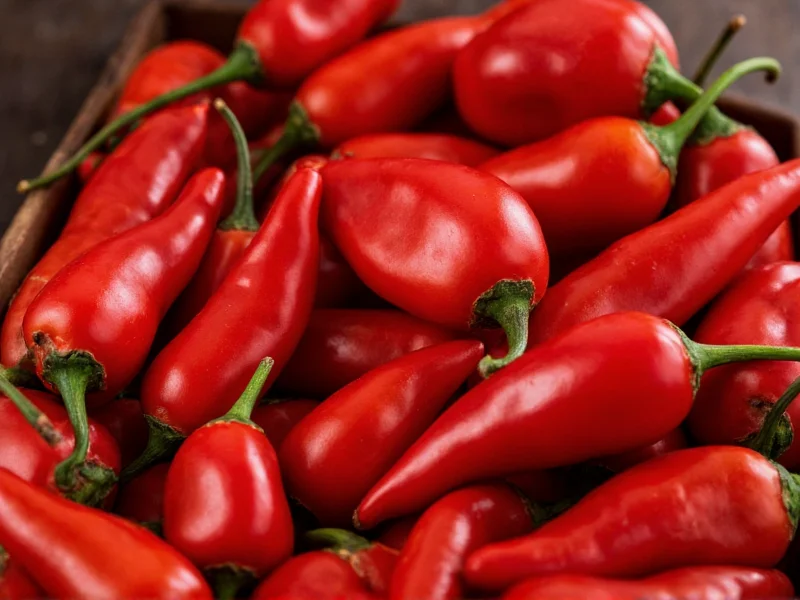The Biochemistry Behind Chili Heat
When you bite into a chili pepper, you're experiencing a sophisticated chemical interaction between capsaicinoids—primarily capsaicin—and your body's sensory system. These lipid-soluble compounds bind to TRPV1 receptors (Transient Receptor Potential Vanilloid 1), which normally detect potentially harmful temperatures above 43°C (109°F). This neurological trick makes your brain register heat where none physically exists.
Chili plants evolved capsaicin production approximately 15-20 million years ago as a defense against seed-destroying mammals, exploiting a key biological difference: birds lack functional TRPV1 receptors and thus disperse seeds without discomfort. Human interaction with chilies spans millennia, with archaeological evidence from Oaxaca, Mexico, dating domestication to approximately 4000 BCE (National Science Foundation). Following Columbus's 1493 arrival in the Americas, chilies rapidly transformed global cuisines—from Korean gochujang to Indian vindaloo—demonstrating how a plant defense mechanism became integral to culinary traditions worldwide.
Measuring the Burn: Understanding Heat Levels
The Scoville scale, developed by pharmacist Wilbur Scoville in 1912, quantifies chili heat through human taste panels. Modern laboratories now use High-Performance Liquid Chromatography (HPLC) for precise measurement of capsaicinoid concentration, converting results to Scoville Heat Units (SHU).
| Chili Variety | Scoville Heat Units | Capsaicin Content |
|---|---|---|
| Bell Pepper | 0 SHU | 0.00% |
| Jalapeño | 2,500-8,000 SHU | 0.02-0.08% |
| Habanero | 100,000-350,000 SHU | 0.1-0.4% |
| Carolina Reaper | 1,400,000-2,200,000 SHU | 1.4-2.2% |
Why Humans Seek the Burn
Despite the pain response, millions enjoy spicy foods regularly. This paradox stems from our brain's reaction to capsaicin-induced 'threat.' When TRPV1 receptors activate, the body releases endorphins—natural painkillers that create pleasurable sensations. This neurological reward system explains why chili consumption often becomes addictive.
Cultural factors also play significant roles. In tropical regions where food spoils quickly, chilies' antimicrobial properties provided evolutionary advantages. Societies in these areas developed higher tolerance for capsaicin over generations, creating culinary traditions centered around spicy foods.
Factors Influencing Chili Heat Levels
Several elements affect how hot a chili pepper will be:
- Genetics: Different varieties contain varying capsaicinoid profiles
- Stress conditions: Drought or nutrient deficiency increases capsaicin production
- Ripeness: Fully mature peppers generally contain more capsaicin
- Plant location: The placenta (white ribs) holds highest concentration
- Climate: Warmer temperatures typically produce hotter peppers
Managing the Burn: Science-Backed Relief
When capsaicin triggers that burning sensation, understanding the chemistry helps find effective relief. Since capsaicin is oil-soluble, water merely spreads the compound. More effective remedies include:
- Dairy products: Casein protein binds to capsaicin, washing it away
- Fatty foods: Oils dissolve capsaicin for easier removal
- Sugars: Can temporarily counteract the sensation
- Alcohol: Ethanol dissolves capsaicin but may irritate tissues
Interestingly, repeated exposure to capsaicin can desensitize TRPV1 receptors over time, explaining why regular chili eaters develop higher tolerance. This process, called 'defunctionalization,' temporarily reduces receptor sensitivity without causing permanent damage.
Practical Applications of Capsaicin Research
Understanding what makes chillies hot extends beyond culinary curiosity. Researchers have developed numerous applications:
- Pain management patches using controlled capsaicin doses
- Wildlife deterrents that protect crops from mammals
- Self-defense sprays with standardized capsaicin concentrations
- Potential weight loss supplements through metabolic stimulation
Capsaicin-based pain relief demonstrates critical context boundaries: per National Center for Complementary and Integrative Health (NCCIH) guidelines, it provides moderate efficacy for neuropathic pain (e.g., postherpetic neuralgia) and osteoarthritis, but shows limited results for inflammatory conditions like rheumatoid arthritis. It remains contraindicated for individuals with skin lesions, neuropathy-related insensitivity, or compromised thermoregulation, and requires gradual dose escalation to mitigate initial burning sensations.











 浙公网安备
33010002000092号
浙公网安备
33010002000092号 浙B2-20120091-4
浙B2-20120091-4